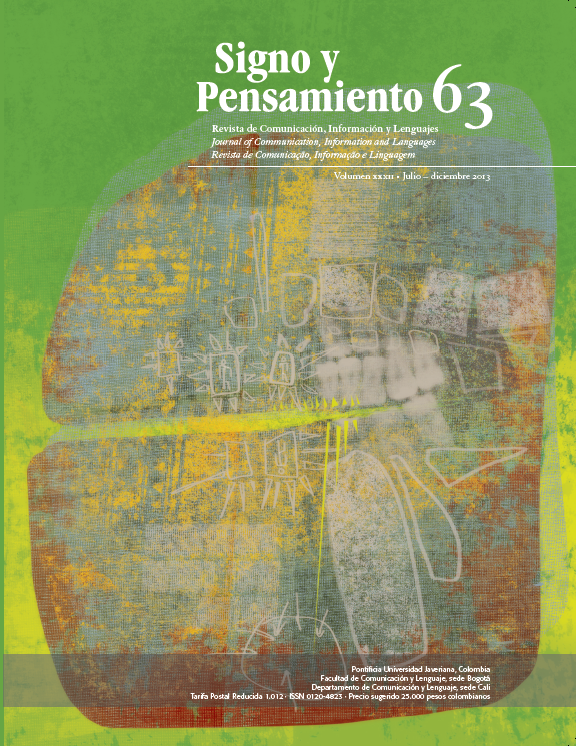Abstract
Public relations, advertising and marketing agencies contribute to the dynamism of the economy of Ecuador, for which they make effective use of communication techniques to strengthen the image and reputation of organizations towards their public. This research aims to determine the support that agencies provide to the integral communication management of organizations. This research is pioneer in the country and is born by the lack of information regarding the agencies. Through quantitative and qualitative research we obtained information related to the companies that offer such support. The results reveal that in Quito and Guayaquil is where the greatest settlement of such companies exists. The advertising and marketing agencies offer integrated communication services; there are also public relations agencies that are increasingly gaining more space in the policy of business communication.
Baack, C. (2010). Publicidad, promoción y comunicación integral en marketing (4ta ed.). México: Pearson Educación.
Brandrepublic (2012). MPG International Media Contacts wins 10 millones Ecuador-Tourismo. Recuperado de http://www.brandrepublic. com/news/1066903/MPG-InternationalMedia-Contacts-wins-10m-Ecuador-Tourism-account/?DCMP=ILC-SEARCH.
Costa, J. (2009). El DirCom hoy. Barcelona: Costa Punto Com.
Departamento de Ciencias de la Comunicación, UTPL. (2012). Anuario de la Comunicación del Ecuador 2011-2012. Loja: EdiLoja.
De Castro, G. (2008). Reputación empresarial y ventaja competitiva. España: ESIC Editorial.
Fernández, M. L. (2008). Comunicación integral e industria publicitaria. Revista Razón y Palabra, 63, julio-agosto. Recuperado de http://www. razonypalabra.org.mx/n63/index63.html.
Garrido, F. J. (2004). Comunicación estratégica: Las claves de la comunicación empresarial en el siglo XXI. Madrid: Gestión 2000.
Gómez-Ramírez, C. M. (2011). Conceptos estratégicos para agencias de relaciones públicas. Criterio Libre, 9 (14), 161-180.
Gutiérrez, O. (2008). Relaciones Públicas en tres tiempos: su cuarta dimensión. En J. D. Barquero, & J. Corredor (Eds.), Relaciones Públicas. Madrid: Ediciones gráficas Rey, S.L.
INEC. (2011). Estadísticas TIC’S 2010. Recuperado de http://www.inec.gob.ec/estadisticas/index. php?option=com_remository&Itemid=&fun c=select&id=93&lang=es.
Islas, O. (Marzo de 2005). De las Relaciones Públicas a la Comunicación Estratégica. Revista Latinoamericana de Comunicación Chasqui, 89, 40-47.
Paladines, F. Y. (2011). Guía didáctica de Marketing UTPL-ECTS. Loja: Ediloja.
Rojas, O. I. (2008). Relaciones Públicas: la eficacia de la influencia (2da ed.). Madrid: Esic.
Santesmases, M. (2012). Marketing conceptos y estrategias (6ta ed.). Madrid: Pirámide.
Túñez, J. M. (2011). La gestión de la comunicación en las organizaciones. Zamora: Comunicación Social.
Valarezo, K., & Túñez, M. (2009). La comunicación de la RSC debe fundamentarse en la ética y la veracidad. Actas del I Congreso Internacional Latina de Comunicación Social. La Laguna (Tenerife), Universidad de La Laguna.
Valarezo, K. (2012). Guía didáctica de Relaciones Públicas UTPL-ECTS. Loja: EdiLoja. Van Riel, C. B. (1997). Comunicación corporativa. Madrid: Pearson Educación S.A.
Véliz, F. (2006). Cambio de mirada en las organizaciones: Comunicación en 360 grados. Revista Latinoamericana de Comunicación Chasqui, 93, 62-65.
Villafañe, J. (1998). Imagen Positiva: Gestión estratégica de la imagen de las empresas. Madrid: Pirámide.
Yaguache-Quichimbo, J. J., & Elizalde, R. (2011). Diagnóstico del estado de las Relaciones Públicas en Ecuador desde el 2000 al 2010. Revista Razón y Palabra. 74, noviembre-enero. Recuperado de http://www.razonypalabra. org.mx/N/N74/VARIA74/31ElizaldeV74.pdf
Wilcox, D., Cameron, G., & Xifra, J. (2006). Relaciones Públicas: Estrategias y tácticas (8va ed.). Madrid: Pearson Educación.
This journal is registered under a Creative Commons Attribution 4.0 International Public License. Thus, this work may be reproduced, distributed, and publicly shared in digital format, as long as the names of the authors and Pontificia Universidad Javeriana are acknowledged. Others are allowed to quote, adapt, transform, auto-archive, republish, and create based on this material, for any purpose (even commercial ones), provided the authorship is duly acknowledged, a link to the original work is provided, and it is specified if changes have been made. Pontificia Universidad Javeriana does not hold the rights of published works and the authors are solely responsible for the contents of their works; they keep the moral, intellectual, privacy, and publicity rights.
Approving the intervention of the work (review, copy-editing, translation, layout) and the following outreach, are granted through an use license and not through an assignment of rights. This means the journal and Pontificia Universidad Javeriana cannot be held responsible for any ethical malpractice by the authors. As a consequence of the protection granted by the use license, the journal is not required to publish recantations or modify information already published, unless the errata stems from the editorial management process. Publishing contents in this journal does not generate royalties for contributors.


